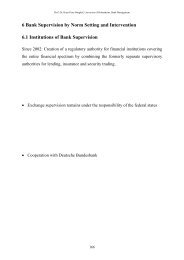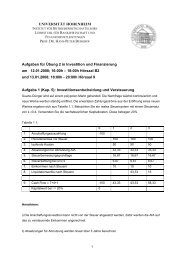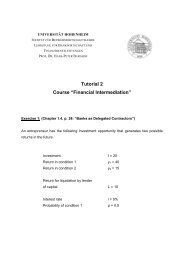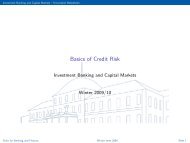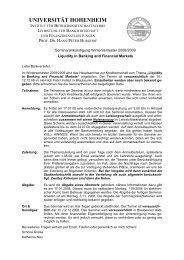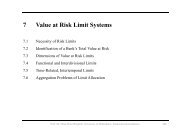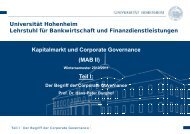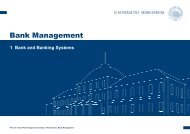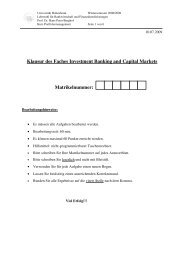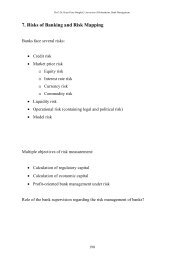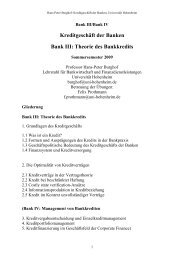Exercises for tutorial 1 in Financial Intermediation - Lehrstuhl für ...
Exercises for tutorial 1 in Financial Intermediation - Lehrstuhl für ...
Exercises for tutorial 1 in Financial Intermediation - Lehrstuhl für ...
Create successful ePaper yourself
Turn your PDF publications into a flip-book with our unique Google optimized e-Paper software.
UNIVERSITÄT HOHENHEIM<br />
INSTITUT FÜR BETRIEBSWIRTSCHAFTSLEHRE<br />
LEHRSTUHL FÜR BANKWIRTSCHAFT UND<br />
FINANZDIENSTLEISTUNGEN<br />
PROF. DR. HANS-PETER BURGHOF<br />
<strong>Exercises</strong> <strong>for</strong> <strong>tutorial</strong> 1 <strong>in</strong> F<strong>in</strong>ancial <strong>Intermediation</strong><br />
Exercise 1: (Chapter 1.2: „Banks as liquidity providers“, page 4.)<br />
a)<br />
Given is a random number of 2 types of depositors.<br />
T1 realises with probability π1=0.5. The demand <strong>for</strong> consumption is short term (i.e. t1).<br />
T2 realises with probability π2=0.5. The demand <strong>for</strong> consumption is long term (i.e. t2).<br />
In t0 the depositors have to make their <strong>in</strong>vestment decision. Thereby they don’t know<br />
their type. It is assumed that depositors put their <strong>for</strong>tune of 1 <strong>in</strong> the bank (f<strong>in</strong>ancial<br />
<strong>in</strong>termediary). It is assumed that the bank knows frequencies π1 and π2.<br />
Given a depositor <strong>in</strong> autarchy there are follow<strong>in</strong>g terms:<br />
ln ; 0.8; 1.3; 0.5; 0.8<br />
The depositor maximizes his expected utility by long term production technology and<br />
liquidation option.<br />
max<br />
<br />
∗ ∗∗ s.t.<br />
111 10.2<br />
11 10.3<br />
Determ<strong>in</strong>e a value <strong>for</strong> <strong>in</strong>vestment I that enables optimal quantities of<br />
∗ ∗<br />
consumption , <strong>in</strong> autarchy.<br />
Determ<strong>in</strong>e the optimal quantities of consumption <strong>in</strong> autarchy.
)<br />
Now depositors can put their money <strong>in</strong> a bank. They can either get an amount of c1<br />
<strong>in</strong> t1 or an amount of c2 <strong>in</strong> t2.<br />
∗ ∗ Determ<strong>in</strong>e the maximum quantities of consumption , a bank could offer<br />
without suffer<strong>in</strong>g an expected loss.<br />
Comment your result.<br />
The bank maximizes the utility of all depositors respectively the expected utility of an<br />
average depositor.<br />
max ∗ ∗∗ <br />
s.t. <br />
1<br />
Bank’s view: Payout will be amount with probability of or with probability of<br />
.<br />
Depositors’ view: A depositor „<strong>in</strong>vests“ the amount of 1 <strong>in</strong> the bank. Hence, the<br />
expected return has to be at least 1.<br />
c)<br />
Repeat your calculation from exercise b). Differ<strong>in</strong>g, assume a rate of time<br />
preference of 0.5.<br />
Comment your result <strong>in</strong> view of stability of the bank.
Exercise 2: (Chapter 1.2: „Banks as liquidity providers“, page 11.)<br />
Given are the follow<strong>in</strong>g bus<strong>in</strong>ess opportunities of a bank:<br />
1. 130 monetary unit credit (marg<strong>in</strong>: 3%), subsequent payment of 40 monetary<br />
units with probability of 12%<br />
2. 110 monetary units deposit (marg<strong>in</strong>: 1%), premature payout <strong>in</strong> of 30 monetary<br />
unit with probability of 8%<br />
3. borrow<strong>in</strong>g at capital market (marg<strong>in</strong>: 0%)<br />
4. <strong>in</strong>vestment <strong>in</strong> cash (marg<strong>in</strong>: -4%)<br />
5. costs <strong>for</strong> short term acquisition of liquidity: 40%<br />
Liquidity shocks are correlated as followed:<br />
Demand <strong>in</strong> liquidity of particular states<br />
withdrawal no withdrawal<br />
additional loans 70 (p=0.05) 40 (p=0.07)<br />
no additional loans 30 (p=0.03) 0 (p=0.85)<br />
Assum<strong>in</strong>g follow<strong>in</strong>g conditions determ<strong>in</strong>e the return of a bank balance:<br />
i) Pure f<strong>in</strong>anc<strong>in</strong>g corporation (only credit bus<strong>in</strong>ess, no deposit bus<strong>in</strong>ess).<br />
(With and without liquidity buffer. Assume a liquidity buffer that offsets every<br />
expected loss.)<br />
ii) Bank with deposit bus<strong>in</strong>ess and credit bus<strong>in</strong>ess.<br />
(With and without liquidity buffer. Assume a liquidity buffer that offsets every<br />
expected loss.<br />
Can you mention an alternative liquidity buffer that <strong>in</strong>creases the profit of the bank?)



